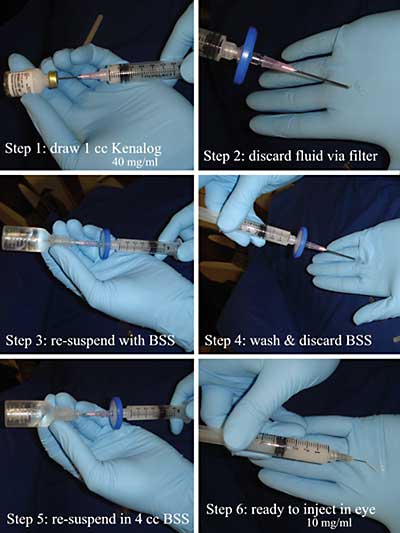Careful triamcinolone use helps inflammation
Click Here to Manage Email Alerts

Intraoperative triamcinolone use has been described in many situations. However, it is not labeled for intraocular use, and its preservatives may have adverse effects on delicate ocular structures.
 Uday Devgan |
James P. Gills, MD, has shown through thousands of cataract surgeries that a small dose of intraocular triamcinolone is effective at controlling postoperative inflammation.
For cases in which I anticipate an aggressive inflammatory response, I am a believer in supplementing my routine postoperative topical steroid drop with intraocular triamcinolone. These are eyes with issues such as uveitis, brunescent cataracts, trypan blue use or iris synechiae.
Paul Koch, MD, was one of the pioneers of using triamcinolone to stain the vitreous in cases in which there was compromise of the posterior capsule. This technique is so valuable and effective that it is likely the standard of care when performing an anterior vitrectomy. It is important to note that the triamcinolone particles will adhere to the outermost part of the prolapsed vitreous and that after performing the anterior vitrectomy, additional triamcinolone should be injected to ensure a complete cleanup.
Many retina specialists are using triamcinolone injections to treat posterior segment inflammatory diseases and macular edema. Perhaps injecting intravitreal triamcinolone at the time of cataract surgery may be of benefit to this subset of patients. For most of these patients, however, I prefer to refer the patient back to my retina colleagues for further management.
Finally, I like the use of triamcinolone to check for aqueous outflow during glaucoma procedures. Injecting a small amount of triamcinolone into the anterior chamber will permit visualization of outflow through the shunt or device and will have a beneficial effect of reducing inflammation at the conjunctival level.
Sterilizing triamcinolone particles
Triamcinolone can be purchased in single-use vials as Kenalog (Bristol Meyers Squibb) suspension in 40 mg/mL or 10 mg/mL concentrations, both of which have significant preservatives when taken straight from the bottle. For this reason, I prefer to remove the liquid carrier, wash the triamcinolone particles and re-suspend them in sterile balanced salt solution.
Here are the steps to sterilizing the triamcinolone particles:
Step 1. Draw 1 cc of Kenalog (40 mg/ mL) into a 5 cc syringe.
Step 2. Place a 0.22 µm filter on the syringe and reattach the needle.
Step 3. Expel the fluid through the filter and discard it, thereby trapping the Kenalog particles in the filter.
Step 4. Draw 4 cc of sterile balanced salt solution into the syringe, thereby re-suspending the Kenalog particles.
Step 5. Expel and discard the fluid again and re-suspend the Kenalog particles by drawing up 4 cc of balanced salt solution again. The Kenalog is now washed.
Step 6. Remove the filter and needle and attach a blunt canula for intraocular use. The final concentration of Kenalog is 10 mg/mL.
|
Images: Devgan U |
Anterior chamber use
For staining prolapsed vitreous in the anterior chamber, this concentration of triamcinolone works well and most of it is removed during the course of the anterior vitrectomy. For controlling post-cataract inflammation, an intraocular dose of about 2 mg is usually sufficient, 0.2 cc of the suspension described above, which is just a few drops worth.
When triamcinolone is injected into the anterior chamber it may cause a light dusting of the iris and perhaps even a small accumulation in the inferior angle for a few days. The risk of steroid-induced IOP spike is thought to be dose-related and perhaps less so with anterior chamber administration as the drug does not typically stay in the anterior chamber for more than a week.
Triamcinolone is an important medication for use in anterior segment surgery, particularly in complicated cases. By removing the preservatives from the suspension and formulating an appropriate concentration, we can maximize its beneficial properties while minimizing ocular toxicity and side effects.
For more information:
- Uday Devgan, MD, FACS, is in private practice in Los Angeles, acting chief of ophthalmology at Olive View-UCLA Medical Center and an assistant clinical professor at the Jules Stein Eye Institute at the University of California, Los Angeles. He can be reached at 10921 Wilshire Blvd., #900, Los Angeles, CA 90024 U.S.A.; +1-310-208-3937; fax: +1-310-208-8058; e-mail: devgan@ucla.edu;Web site: www.maloneyvision.com.
Reference:
- Gills JP, Gills P. Effect of intracameral triamcinolone to control inflammation following cataract surgery. J Cataract Refract Surg. 2005; 31(8):1670-1671.

